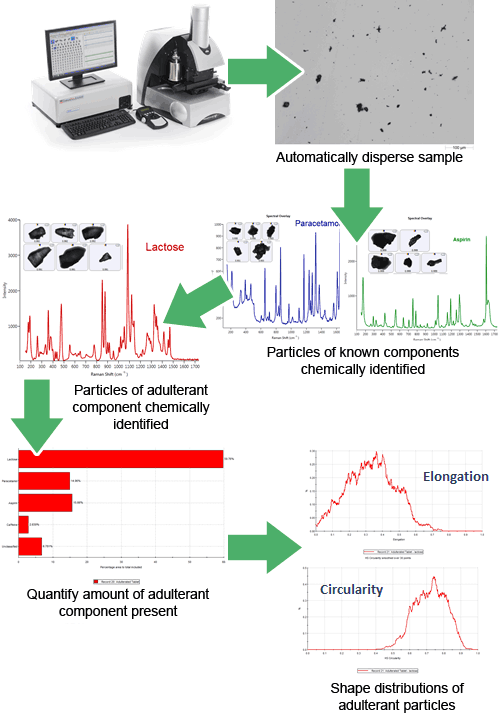The Morphologi G3-ID provides, by automatically quantifying, the percent of each chemical, both active and diluent, a robust “fingerprint” of the illicit drug sample, that can potentially be used to link a street drug seizure back to the dealer/source.
Adulteration in the context of street drugs can be defined as introduction of pharmacologically active substance (for example caffeine, creatine, lidocaine, phenacetin, etc.) to the illicit drug, for similar or enhanced effect of the illicit drug. Dilution on the other hand is where substances like sugars (lactose, sucrose and glucose), which are pharmacologically inactive and added to the bulk of the illicit drug to increase profit for the dealers.
Drugs like heroin, amphetamine and cocaine are often extensively mixed or “cut” with a variety of adulterants and/or diluents, in order to make it appear that there is larger amount of drug than is actually present, thereby increasing the dealer’s profits. Identification of these substances is important because these may be more toxic on their own or in combination with the illicit drug. Most importantly, the use of these adulterants and diluents by drug dealers and resulting unexpected drug purities and effects has a potential of endangering the lives of drug users.
Characterization of these substances becomes important in supporting comparative analysis linking two or more samples together. Detailed knowledge and understanding of cutting agents may also provide information about distribution routes of illicit drugs and help in bringing criminals to justice.
The Morphologi G3-ID provides size, shape and chemical identification for particles in the size range 1 µm to 1000 µm for a variety of sample types, including dry powders, liquids and creams. It operates by scanning a particle dispersion and using advanced optics to capture images of individual particles. The system then automatically selects particles within the dispersion and collects a Raman spectrum from each one, allowing them to be classified and grouped in terms of discrete component populations. Designed for operational ease of use, the fully automated instrument enables particle characterization scientists with even limited spectroscopic experience to gain an in-depth understanding of their particulate samples.
For this paper, the sample used for demonstration is an over the counter cold remedy containing Aspirin, Paracetamol and an unknown substance (diluent) was added to it.
The figure below shows the workflow of the characterization using the Morphologi G3-ID.

|
By automatically quantifying the percent of each chemical, both active and diluent, a robust “fingerprint” of the sample is created that can potentially be used to link a street drug seizure or counterfeit pharmaceutical back to the dealer/source. The Morphologi G3-ID test is NON-Destructive, so the sample is fully recoverable in its original form and can be used for further testing if required.
Subtle differences between different grades of diluents used can also be identified using the optical capabilities of the Morphologi G3-ID, based on differences in circularity and/or elongation which could help in connecting samples from the field to their source or distribution channels.